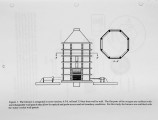| OCR Text |
Show All of the experimental work discussed here was performed on the John Zink PDA-12 burner sho,:n in Figure 2. The gas is introduced through four individual fuel spuds with three holes in each tIp. Each of the 12 holes gives rise to an individual non-premixed flame inside the quarl. Experimental Setup Mie Scattering Diagnostics Planar Mie scattering is a technique where laser light, formed into a sheet, scatters off seed particles introduced into the fuel or air, revealing the interface between seeded fluid entering the furnace and un seeded fluid already in the furnace. The frequency-doubled beam from aNd: Y AG laser (532 nm) is formed into a sheet approximately 0.5 mm thick using cylindrical lenses that expand the beam in one dimension. The Nd: Y AG pulse duration of 6 ns effectively freezes the flow. In order to eliminate flame and background radiation, we used a narrow band-pass interference filter centered on the 532 nm doubled Nd:YAG line, and an electronic gated shutter (1 J.ls gate time). To achieve low light level imaging, the BERL is equipped with a high resolution Photometrics 1024 x 1024 pixel CCD detector coupled with an electronically gated image intensifier. The camera signal is digitized using a 14 bit AT200 CCD system and processed using PMIS Microsoft Windows software. To obtain the highest possible contrast, the seeding is started and stopped impulsively. This allows the furnace to completely clear of seed before each ensuing image. Because of limited optical access in the PDA burner, the laser was directed toward the fuel nozzle itself creating a very intense reflection which could not be filtered nor gated. This intense reflection was eliminated by image processing using the PMIS system. Images were processed by subtracting an image of the visualized region including laser light but without seed from each Mie scattering image of the jet. This subtracted image was then multiplied by a band threshold [0, Nmax]; where Nmax is the gray level value characteristic of the maximum Mie scattering signal (near the jet nozzle). The pixels having gray levels less than zero or greater than Nmax were all set to zero. Jet Imaging Operating Conditions The baseline operating condition was firing natural gas at 2 MMBtulh with 25% excess air. Also, to study the influence of the air flow on the turbulent jet structure, 10% excess and 39% excess air cases were also investigated at the same firing rate for the jet imaging study. The operating conditions are reported on Table 1. Single jet access set up Mie scattering images of the mixing characteristi~s of one of ~he radially-in~ard natural gas jets (see Fig. 2) in the quarl of the PDA burner were obtaIned by seedIng the fuel WIth a 0.5 s pulse of TiO particles. A 300 mm tall, 0.5 ~ thick Nd: Y AG laser sh~et was focused along the, vertical plan~ intersecting the centerline of the Jet. In order to observe the Jet near the bottom of the eight inch dee quarl, the laser and the CCD camera were set at a 45° angle according to the setup shown on Figure i 3 |

































